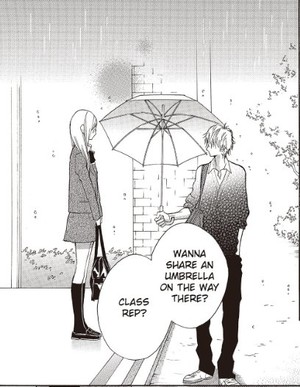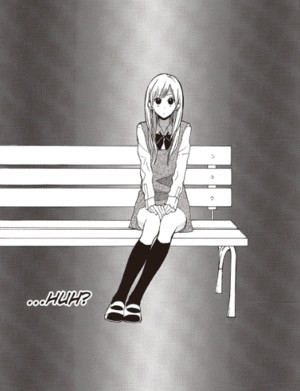The Fall 2020 Manga Guide
When We're in Love
What's It About?
 Nanase Sakashita is good at playing the role of model student but that doesn't stop her from taking an interest in Hana-kun, the school's delinquent. Hana-kun accidentally drops a small box while sneaking around on the school grounds. When Nanase tries to return the box, Hana-kun tells her to keep it for its already too late to give it to the person he likes.
Nanase Sakashita is good at playing the role of model student but that doesn't stop her from taking an interest in Hana-kun, the school's delinquent. Hana-kun accidentally drops a small box while sneaking around on the school grounds. When Nanase tries to return the box, Hana-kun tells her to keep it for its already too late to give it to the person he likes.When We're in Love is drawn and scripted by Fuyu Kumaoka. The digital version of Volume 1 is currently available at Kodansha Comics for $10.99.
Is It Worth Reading?

Rebecca Silverman
Rating:
If you're in the mood for a by-the-numbers cute little shoujo romance, the first volume of When We're in Love has got you covered. It's so basic a shoujo romance that it's almost a little boring – high school first year and class rep Nanase has a run-in with class troublemaker Hana-kun as he sneaks out of detention. She doesn't turn him in. He starts being nice to her. She forms a crush on him, but oh no! He (probably) likes their homeroom teacher. End scene.
There's literally nothing going on in this book that you haven't read before if you're a fan of the genre, and really, that's okay. It also stays away from the more troubling aspects of it – Hana never kisses Nanase without her consent (or at all), no one's pinned against a wall, no skirts are looked up even when Hana's crawling out of a basement window right next to skirt-wearing Nanase. Even the scene where the two share an umbrella and go out for ramen is wholesomely tame. That makes this a very nice brain break when you just want the literary equivalent of Cream of Wheat, but also a good bet for younger romance readers who just want to see a guy and a girl get together without a lot of extra baggage. It's like romance with training wheels.
I realize that this sounds awfully like I'm damning the book with faint praise. I don't mean to – it's just that this is so very simple and straightforward that there isn't much to say beyond that. It's a perfectly fine book that doesn't have high stakes – we can easily guess where things are headed now that Hana's probably figured out that Nanase likes him – and it really doesn't need to be anything beyond that. Makes for a boring review, but it's a sort of reassuringly simple story and nothing more than that.

Caitlin Moore
Rating:
As I read When We're in Love, I couldn't stop thinking about a particular gag in the delightful Lovely Complex. When the heroine Risa asks her friend Nobu how she got with her boyfriend, Nobu starts telling her about a shoujo-esque love story where he was the toughest guy in school and everyone was afraid of him, but one day she followed him and found him caring for a box of abandoned kittens. Before she can finish her story, she bursts out laughing and says they actually got together in an extremely normal way. (Please don't comment saying I got some detail here wrong; it's been a while since I've read or watched the series but the sentiment is the same.)
I also kept thinking of Let's Fall in Love, the manga-within-a-manga in Monthly Girls' Nozaki-kun, which is intentionally as full of shoujo romance stereotypes as possible and a way for the series to gently rib the genre.
I thought of these because When We're in Love is the exact kind of manga they're making fun of. It's cliche after cliche, a parade of stereotypes that indicates absolutely zero original thought went into it. The smart girl has a chance with the resident bad boy and starts noticing details about him she thinks is cute! It turns out he's not as tough as everyone thinks! She has an internal narration about her chest feeling tight when she looks at him! The art looks like if you made a composite over every '00s and '10s shoujo manga and took the average.
It reads like a parody but oh, it is so very sincere. I try to be kind to media aimed at teenage girls because so few people are, but school romcoms are the tofu of shoujo manga: you have to prepare them really well and add some other elements for flavor, or else it ends up a pile of flavorless mush. I know I've spent half this review talking about other series but there's just nothing to say and nothing to see here. It gets two stars instead of one because there wasn't anything to actively dislike about it, or really trigger any kind of emotional reaction.
discuss this in the forum (29 posts) |
back to The Fall 2020 Manga Guide
Feature homepage / archives